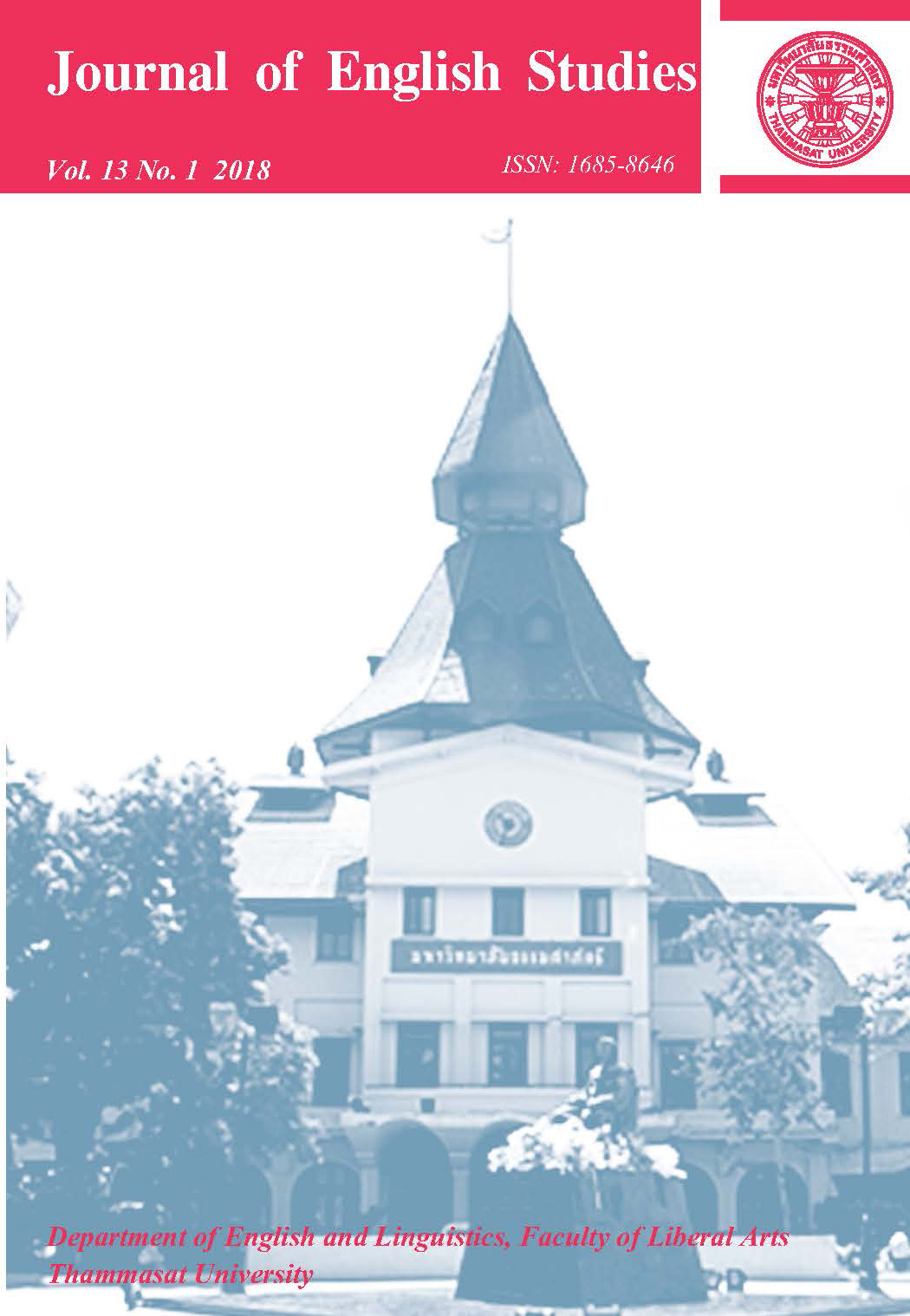Gender-Differential Tendencies in LINE Use: A Case of Thailand
Main Article Content
Abstract
The study investigates the gender-differential tendencies in the use Thai final particles and virtual stickers in LINE, a popular instant-messaging platform in Thailand. The data are gathered from a group chat of 13 participants who are or were working for a company in Thailand. Three thousand, three hundred and eighty four messages were analyzed and four participants were selected for follow-up interviews. The results reveal that the female users tend to use final particles more than the male users do. However, the male users appear to use more virtual stickers than the female users do. The study concludes that such differences are not solely determined by gender; rather, they are socially constructed and shaped by the nature of the platform.
Article Details
References
Barton, D. (2007). Literacy: An introduction to the ecology of written language (2nd ed.). Oxford,UK: Blackwell.
Barton, D., & Hamilton, M. (1998). Local literacies. London: Routledge.
Barton, D., & Hamilton, M. (2000). Literacy practices. In D. Barton, M. Hamilton, & R. Ivanic (Eds.), Situated literacies (pp. 7-15). London: Routledge.
Barton, D., & Lee, C. (2013 ). Language online: investigating digital texts and practices. London: Routledge.
Baron, N. S. 2000. Alphabet to email: How written English evolved and where it’s
heading. London and New York: Routledge.
Baron, N. S. 2004. See you online: Gender issues in college student use of instant
messaging. Journal of Language and Social Psychology 23(4), 397-423.
Cameron, D. 1992. Feminism and Linguistic Theory (2nd ed.). London: Macmillan.
Coates, Jennifer. 1993. Women, men and language: A sociolinguistic account of gender differences in language. New York: Longman.
Cooke, J. R. (1989) Thai sentence particles and other topics, Pacific Linguistic, Series A-80: Papers in South-East Asian Linguistics No.12, Canberra : The Australian National University.
Crystal, D. 2001: Language and the Internet. Cambridge: Cambridge University Press.
Danet, B. 1998. Text as mask: Gender and identity on the Internet. In S.Jones (Ed) Cybersociety 2.0, 129-58. Thousand Oaks, CA: Sage.
Fishman, Pamela. 1983. Interaction: The work women do. In Thorne, Kramarae and Henley (Eds.): Language, Gender and Society. Boston: Heinle and Heinle.
Gee, J. P. (1996). Social linguistics and literacies. London: Routledge.
Graddol, D. & Swann, J. (1989). Gender Voices. Cambridge: Basil Blackwell.
Guiller, Jane& Durndell Alan (2006): Students’ linguistic behavior in online discussion groups: Does gender matter? Computers in Human Behavior 23, 2240-2255.
Herring, S. 1992. Gender and participation in computer-mediated linguistic discourse.Washington, D.C.: ERIC Clearinghouse on Languages and Linguistics.
Document no. ED345552.
Herring, Susan C. 1993. Gender and democracy in computer-mediated communication: Electronic Journal of Communication, 3(2).
Herring, S. 1996. Two variants of an electronic message schema, in S. Herring (Ed)
Computer-mediated communication: Linguistic, social, and cross-cultural
perspectives, (pp.81-106). Amsterdam: John Benjamins.
Herring, Susan C. 1998. Virtual gender performances. Talk presented at Texas A&M
University.
Herring, S. 2000. Gender Differences in CMC: Findings and Implications. CPSR
Newsletter 18, 1. R Retrieved April 2, 2013, from https://www.cpsr.org/issues/womenintech/herring.
Herring, S. (2003). Gender and power in on-line communication. In J. Holmes &
M. Meyerhoff (Eds.), The handbook of language and gender (pp. 202-228). Malden,MA: Blackwell.
Herring,S., & Panyametheekul,S. (2007 ). Gender and Turn Allocation in a Thai Chat Room. In B. Danet & S. Herring (eds), The multilingual internet: language, culture and communication online (pp. 303-318). New York: Oxford University Press.
Hirschamn, L. 1994: Female-male differences in conversational interaction. Language in Society, 23, 427-442.
Holmes, Janet. 1995. Women, Men and Politeness. London: Longman.
Hongladarom, K., & Hongladarom, S. (2005). Politeness in Thai computer-mediated communication. In R. Lakoff & S. Ide (Eds.), Broadening the horizon of linguistic politeness (pp. 145–162). Amsterdam: John Benjamins.
Ingkaphirom, P. (1994). How language reflects the status of women in the Thai and Japanese socisties. In M. Bucholtz, A. Liang, L. Sutton, & C. Hines (Eds.), Cultural performances: Proceedings of the third Berkeley Women and Language Conference (pp. 102–115). Berkeley, CA: Berkeley Women and Language Group.
Jespersen, O. 1922. Language: Its Nature, Development and Origin. New York: Allen
and Unwin.
Lakoff, R. 1975. Language and Women’s Place. New York: Harper and Row.
Lee, C., (2007). Affordances and text-making practices in online instant messaging. Written Communication, 24(3), 223-248.
Luke, C. (2003). Pedagogy, connectivity, multimodalilty, and inter- disciplinarity. Reading Research Quarterly, 38, 397–403.
McMillan, J. R., Clifton, A. K., McGrath, D. and Gale, W. S. 1977: Women’s language: Uncertainty or interpersonal sensitivity and emotionality? Sex Roles, 3, 545-559.
Mei, Y. (2006). The Gender Differences in Linguistic Features of Dyadic Synchronous Computer-mediated Communication. MA Thesis, The Chinese University of Hong Kong
Mulac, A., Wiemann, J. M., Widenmann, S. J. & Gibson, T. W. 1988: Male/female language differences and effects in same-sex and mixed-sex dyads: The gender-linked language effect. Communication Monographs, 55, 315-335.
Tannen, Deborah. (1984). Coherence in Spoken and Written Discourse. Norwood, NJ: Ablex.
Tannen, D. (1990). You Just Don’t Understand! Women and Men in Conversation.
London: Virago.
Thomson, Rob , Tamar Murachver and James Green. (2001). Where is the gender in gendered language? Psychological Science .12, 171-175.
Simpson, R. C. (1997). Negotiating identities in Thai conversation: A sociolinguistic discourse analysis of person-referring expressions. Unpublished Ph.D. dissertation, University of Michigan.
Street, B. V. (1993). Introduction: The new literacy studies. In B. V. Street (Ed.), Cross-cultural approaches to literacy (pp. 1-21). Cambridge, UK: Cambridge University Press.


